Employment Relations: Understanding Disability Discrimination and Reasonable Adjustments
VerifiedAdded on 2023/06/14
|12
|3537
|203
AI Summary
This article discusses the provisions of the Equality Act 2010 in relation to disability discrimination and reasonable adjustments. It covers the definition of disability, protected characteristics, and specific provisions for discrimination arising from disability. The article also discusses relevant cases and challenges faced by businesses in complying with the law.
Contribute Materials
Your contribution can guide someone’s learning journey. Share your
documents today.
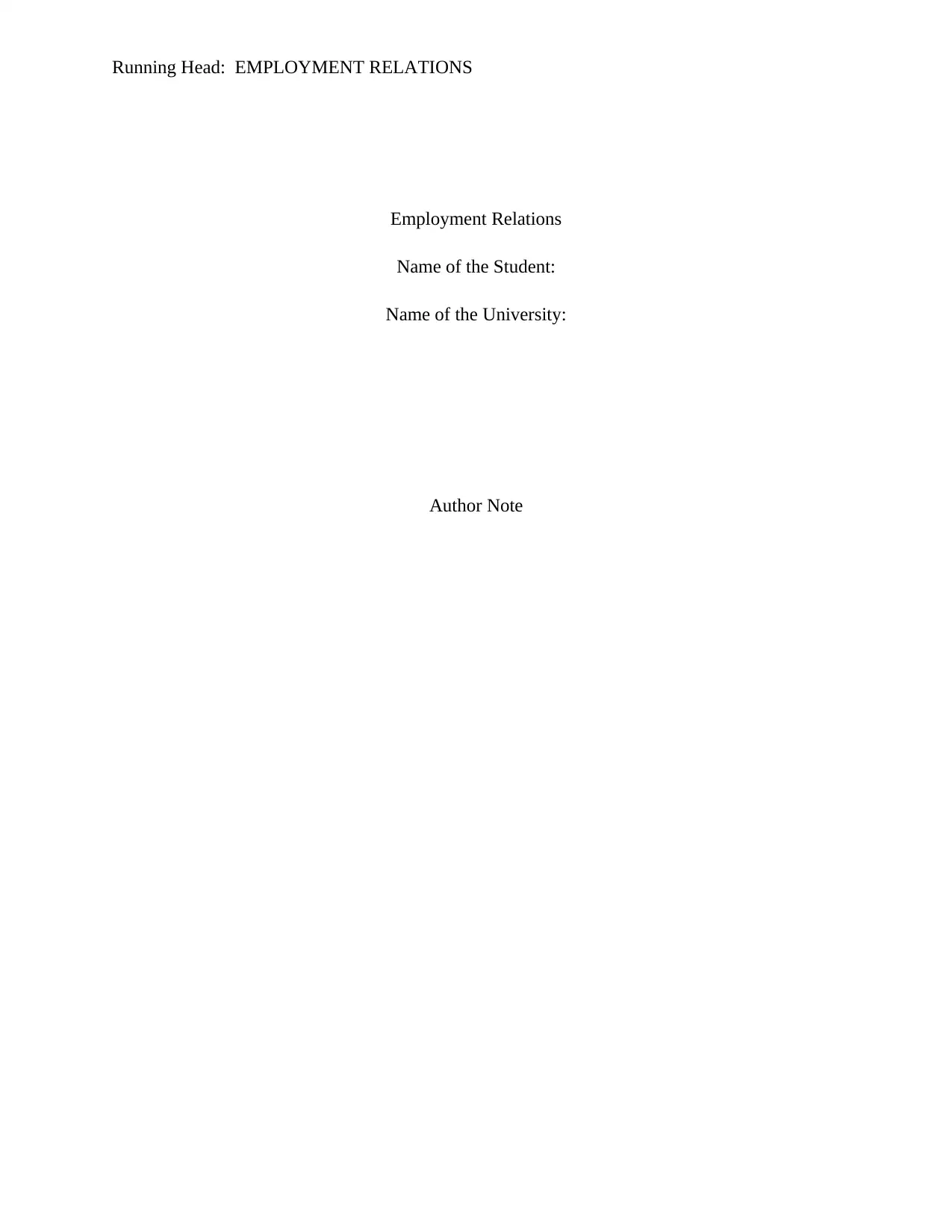
Running Head: EMPLOYMENT RELATIONS
Employment Relations
Name of the Student:
Name of the University:
Author Note
Employment Relations
Name of the Student:
Name of the University:
Author Note
Secure Best Marks with AI Grader
Need help grading? Try our AI Grader for instant feedback on your assignments.
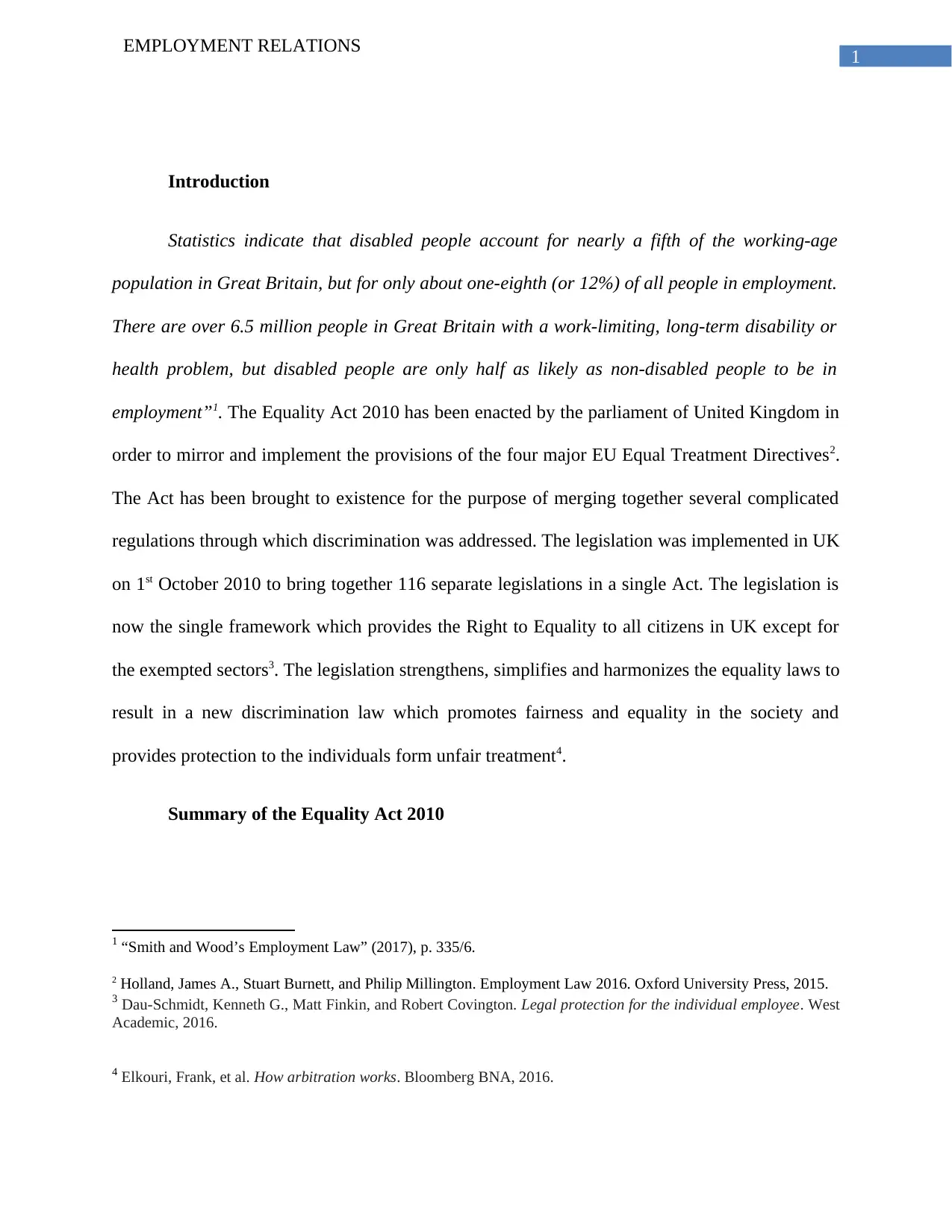
1
EMPLOYMENT RELATIONS
Introduction
Statistics indicate that disabled people account for nearly a fifth of the working-age
population in Great Britain, but for only about one-eighth (or 12%) of all people in employment.
There are over 6.5 million people in Great Britain with a work-limiting, long-term disability or
health problem, but disabled people are only half as likely as non-disabled people to be in
employment”1. The Equality Act 2010 has been enacted by the parliament of United Kingdom in
order to mirror and implement the provisions of the four major EU Equal Treatment Directives2.
The Act has been brought to existence for the purpose of merging together several complicated
regulations through which discrimination was addressed. The legislation was implemented in UK
on 1st October 2010 to bring together 116 separate legislations in a single Act. The legislation is
now the single framework which provides the Right to Equality to all citizens in UK except for
the exempted sectors3. The legislation strengthens, simplifies and harmonizes the equality laws to
result in a new discrimination law which promotes fairness and equality in the society and
provides protection to the individuals form unfair treatment4.
Summary of the Equality Act 2010
1 “Smith and Wood’s Employment Law” (2017), p. 335/6.
2 Holland, James A., Stuart Burnett, and Philip Millington. Employment Law 2016. Oxford University Press, 2015.
3 Dau-Schmidt, Kenneth G., Matt Finkin, and Robert Covington. Legal protection for the individual employee. West
Academic, 2016.
4 Elkouri, Frank, et al. How arbitration works. Bloomberg BNA, 2016.
EMPLOYMENT RELATIONS
Introduction
Statistics indicate that disabled people account for nearly a fifth of the working-age
population in Great Britain, but for only about one-eighth (or 12%) of all people in employment.
There are over 6.5 million people in Great Britain with a work-limiting, long-term disability or
health problem, but disabled people are only half as likely as non-disabled people to be in
employment”1. The Equality Act 2010 has been enacted by the parliament of United Kingdom in
order to mirror and implement the provisions of the four major EU Equal Treatment Directives2.
The Act has been brought to existence for the purpose of merging together several complicated
regulations through which discrimination was addressed. The legislation was implemented in UK
on 1st October 2010 to bring together 116 separate legislations in a single Act. The legislation is
now the single framework which provides the Right to Equality to all citizens in UK except for
the exempted sectors3. The legislation strengthens, simplifies and harmonizes the equality laws to
result in a new discrimination law which promotes fairness and equality in the society and
provides protection to the individuals form unfair treatment4.
Summary of the Equality Act 2010
1 “Smith and Wood’s Employment Law” (2017), p. 335/6.
2 Holland, James A., Stuart Burnett, and Philip Millington. Employment Law 2016. Oxford University Press, 2015.
3 Dau-Schmidt, Kenneth G., Matt Finkin, and Robert Covington. Legal protection for the individual employee. West
Academic, 2016.
4 Elkouri, Frank, et al. How arbitration works. Bloomberg BNA, 2016.

2
EMPLOYMENT RELATIONS
The legislation provides that a person must not be discriminated against nine specific
traits or characteristics. There is no intention required on the part of the employer for being liable
for a discrimination claim. If a person possesses any of the nine protected characteristics and
have been provided an unfair treatment as compared to those who do not possess such traits, the
aggrieved party can make a claim for discrimination. This form of discrimination is a direct form
of discrimination as provided through the provisions of section 13 of the EA5. The nine
characteristics which are specifically protected by the Act include disability, gender, age,
religious belief, race, maternity, matrimonial status, sexual orientation and gender reassignment.
Further a person can also be liable for a discrimination claim if the discrimination in context has
been done indirectly. Section 19 of the EA provides the definition of an indirect discrimination.
According to the section if policy and procedures are enacted by the employer which subjects the
employee to an unfair disadvantage due to his protective trait then it is an act of indirect
discrimination6. Section 6 of the EA specifically provides the meaning of the word disability in
the context of the legislation. The section states that a person A will been deemed as disable if he
possesses a physical or mental impairment and the impartment is of such a nature that it has a
long terms and substantial adverse effect on his ability to carry out general daily activities. Any
reference to a disabled person signifies reference to a person who has disability as per the above
definition7.
Specific provisions have been provided in relation to discrimination arising from
disability under the provisions of section 15 of the EA8. It has been provided through the section
5 Act, Equality. "c. 13." Retrieved from the UK National Archives website: http://www. legislation. gov.
uk/ukpga/2010/15/contents (2010).
6 Act, Equality. "c. 19." Retrieved from the UK National Archives website: http://www. legislation. gov.
uk/ukpga/2010/15/contents (2010).
7 Act, Equality. "c. 6." Retrieved from the UK National Archives website: http://www. legislation. gov.
uk/ukpga/2010/15/contents (2010).
8 Act, Equality. "c. 15." Retrieved from the UK National Archives website: http://www. legislation. gov.
uk/ukpga/2010/15/contents (2010).
EMPLOYMENT RELATIONS
The legislation provides that a person must not be discriminated against nine specific
traits or characteristics. There is no intention required on the part of the employer for being liable
for a discrimination claim. If a person possesses any of the nine protected characteristics and
have been provided an unfair treatment as compared to those who do not possess such traits, the
aggrieved party can make a claim for discrimination. This form of discrimination is a direct form
of discrimination as provided through the provisions of section 13 of the EA5. The nine
characteristics which are specifically protected by the Act include disability, gender, age,
religious belief, race, maternity, matrimonial status, sexual orientation and gender reassignment.
Further a person can also be liable for a discrimination claim if the discrimination in context has
been done indirectly. Section 19 of the EA provides the definition of an indirect discrimination.
According to the section if policy and procedures are enacted by the employer which subjects the
employee to an unfair disadvantage due to his protective trait then it is an act of indirect
discrimination6. Section 6 of the EA specifically provides the meaning of the word disability in
the context of the legislation. The section states that a person A will been deemed as disable if he
possesses a physical or mental impairment and the impartment is of such a nature that it has a
long terms and substantial adverse effect on his ability to carry out general daily activities. Any
reference to a disabled person signifies reference to a person who has disability as per the above
definition7.
Specific provisions have been provided in relation to discrimination arising from
disability under the provisions of section 15 of the EA8. It has been provided through the section
5 Act, Equality. "c. 13." Retrieved from the UK National Archives website: http://www. legislation. gov.
uk/ukpga/2010/15/contents (2010).
6 Act, Equality. "c. 19." Retrieved from the UK National Archives website: http://www. legislation. gov.
uk/ukpga/2010/15/contents (2010).
7 Act, Equality. "c. 6." Retrieved from the UK National Archives website: http://www. legislation. gov.
uk/ukpga/2010/15/contents (2010).
8 Act, Equality. "c. 15." Retrieved from the UK National Archives website: http://www. legislation. gov.
uk/ukpga/2010/15/contents (2010).
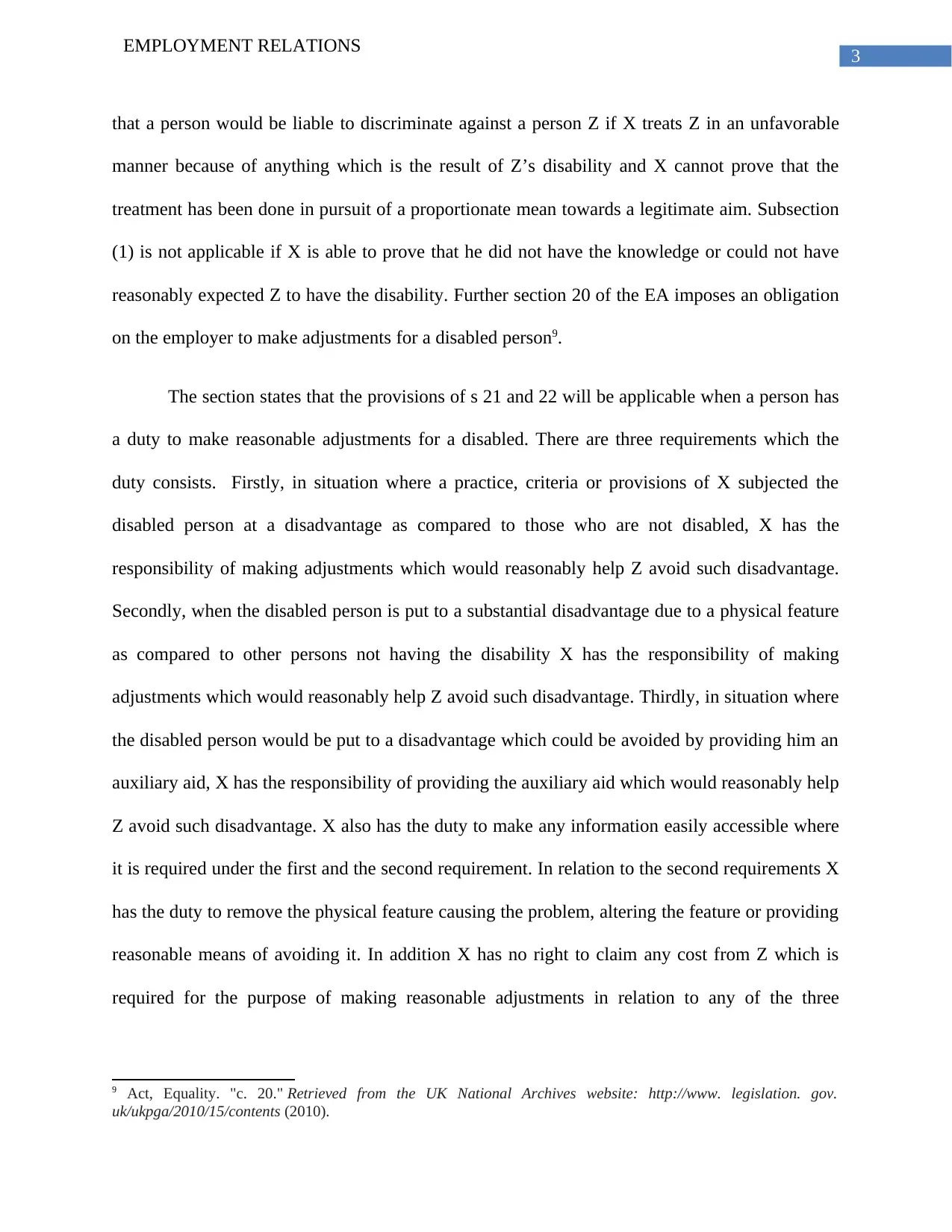
3
EMPLOYMENT RELATIONS
that a person would be liable to discriminate against a person Z if X treats Z in an unfavorable
manner because of anything which is the result of Z’s disability and X cannot prove that the
treatment has been done in pursuit of a proportionate mean towards a legitimate aim. Subsection
(1) is not applicable if X is able to prove that he did not have the knowledge or could not have
reasonably expected Z to have the disability. Further section 20 of the EA imposes an obligation
on the employer to make adjustments for a disabled person9.
The section states that the provisions of s 21 and 22 will be applicable when a person has
a duty to make reasonable adjustments for a disabled. There are three requirements which the
duty consists. Firstly, in situation where a practice, criteria or provisions of X subjected the
disabled person at a disadvantage as compared to those who are not disabled, X has the
responsibility of making adjustments which would reasonably help Z avoid such disadvantage.
Secondly, when the disabled person is put to a substantial disadvantage due to a physical feature
as compared to other persons not having the disability X has the responsibility of making
adjustments which would reasonably help Z avoid such disadvantage. Thirdly, in situation where
the disabled person would be put to a disadvantage which could be avoided by providing him an
auxiliary aid, X has the responsibility of providing the auxiliary aid which would reasonably help
Z avoid such disadvantage. X also has the duty to make any information easily accessible where
it is required under the first and the second requirement. In relation to the second requirements X
has the duty to remove the physical feature causing the problem, altering the feature or providing
reasonable means of avoiding it. In addition X has no right to claim any cost from Z which is
required for the purpose of making reasonable adjustments in relation to any of the three
9 Act, Equality. "c. 20." Retrieved from the UK National Archives website: http://www. legislation. gov.
uk/ukpga/2010/15/contents (2010).
EMPLOYMENT RELATIONS
that a person would be liable to discriminate against a person Z if X treats Z in an unfavorable
manner because of anything which is the result of Z’s disability and X cannot prove that the
treatment has been done in pursuit of a proportionate mean towards a legitimate aim. Subsection
(1) is not applicable if X is able to prove that he did not have the knowledge or could not have
reasonably expected Z to have the disability. Further section 20 of the EA imposes an obligation
on the employer to make adjustments for a disabled person9.
The section states that the provisions of s 21 and 22 will be applicable when a person has
a duty to make reasonable adjustments for a disabled. There are three requirements which the
duty consists. Firstly, in situation where a practice, criteria or provisions of X subjected the
disabled person at a disadvantage as compared to those who are not disabled, X has the
responsibility of making adjustments which would reasonably help Z avoid such disadvantage.
Secondly, when the disabled person is put to a substantial disadvantage due to a physical feature
as compared to other persons not having the disability X has the responsibility of making
adjustments which would reasonably help Z avoid such disadvantage. Thirdly, in situation where
the disabled person would be put to a disadvantage which could be avoided by providing him an
auxiliary aid, X has the responsibility of providing the auxiliary aid which would reasonably help
Z avoid such disadvantage. X also has the duty to make any information easily accessible where
it is required under the first and the second requirement. In relation to the second requirements X
has the duty to remove the physical feature causing the problem, altering the feature or providing
reasonable means of avoiding it. In addition X has no right to claim any cost from Z which is
required for the purpose of making reasonable adjustments in relation to any of the three
9 Act, Equality. "c. 20." Retrieved from the UK National Archives website: http://www. legislation. gov.
uk/ukpga/2010/15/contents (2010).
Secure Best Marks with AI Grader
Need help grading? Try our AI Grader for instant feedback on your assignments.
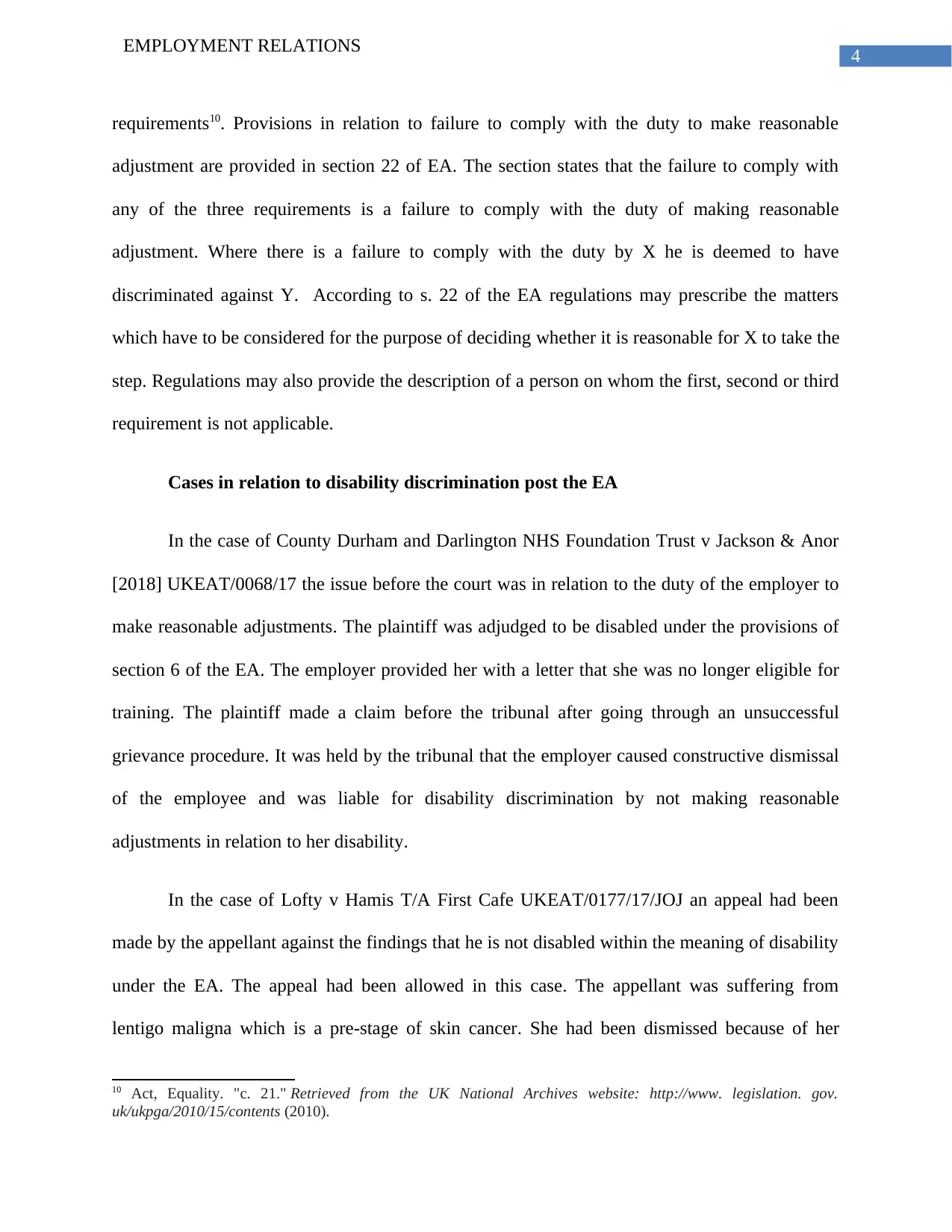
4
EMPLOYMENT RELATIONS
requirements10. Provisions in relation to failure to comply with the duty to make reasonable
adjustment are provided in section 22 of EA. The section states that the failure to comply with
any of the three requirements is a failure to comply with the duty of making reasonable
adjustment. Where there is a failure to comply with the duty by X he is deemed to have
discriminated against Y. According to s. 22 of the EA regulations may prescribe the matters
which have to be considered for the purpose of deciding whether it is reasonable for X to take the
step. Regulations may also provide the description of a person on whom the first, second or third
requirement is not applicable.
Cases in relation to disability discrimination post the EA
In the case of County Durham and Darlington NHS Foundation Trust v Jackson & Anor
[2018] UKEAT/0068/17 the issue before the court was in relation to the duty of the employer to
make reasonable adjustments. The plaintiff was adjudged to be disabled under the provisions of
section 6 of the EA. The employer provided her with a letter that she was no longer eligible for
training. The plaintiff made a claim before the tribunal after going through an unsuccessful
grievance procedure. It was held by the tribunal that the employer caused constructive dismissal
of the employee and was liable for disability discrimination by not making reasonable
adjustments in relation to her disability.
In the case of Lofty v Hamis T/A First Cafe UKEAT/0177/17/JOJ an appeal had been
made by the appellant against the findings that he is not disabled within the meaning of disability
under the EA. The appeal had been allowed in this case. The appellant was suffering from
lentigo maligna which is a pre-stage of skin cancer. She had been dismissed because of her
10 Act, Equality. "c. 21." Retrieved from the UK National Archives website: http://www. legislation. gov.
uk/ukpga/2010/15/contents (2010).
EMPLOYMENT RELATIONS
requirements10. Provisions in relation to failure to comply with the duty to make reasonable
adjustment are provided in section 22 of EA. The section states that the failure to comply with
any of the three requirements is a failure to comply with the duty of making reasonable
adjustment. Where there is a failure to comply with the duty by X he is deemed to have
discriminated against Y. According to s. 22 of the EA regulations may prescribe the matters
which have to be considered for the purpose of deciding whether it is reasonable for X to take the
step. Regulations may also provide the description of a person on whom the first, second or third
requirement is not applicable.
Cases in relation to disability discrimination post the EA
In the case of County Durham and Darlington NHS Foundation Trust v Jackson & Anor
[2018] UKEAT/0068/17 the issue before the court was in relation to the duty of the employer to
make reasonable adjustments. The plaintiff was adjudged to be disabled under the provisions of
section 6 of the EA. The employer provided her with a letter that she was no longer eligible for
training. The plaintiff made a claim before the tribunal after going through an unsuccessful
grievance procedure. It was held by the tribunal that the employer caused constructive dismissal
of the employee and was liable for disability discrimination by not making reasonable
adjustments in relation to her disability.
In the case of Lofty v Hamis T/A First Cafe UKEAT/0177/17/JOJ an appeal had been
made by the appellant against the findings that he is not disabled within the meaning of disability
under the EA. The appeal had been allowed in this case. The appellant was suffering from
lentigo maligna which is a pre-stage of skin cancer. She had been dismissed because of her
10 Act, Equality. "c. 21." Retrieved from the UK National Archives website: http://www. legislation. gov.
uk/ukpga/2010/15/contents (2010).
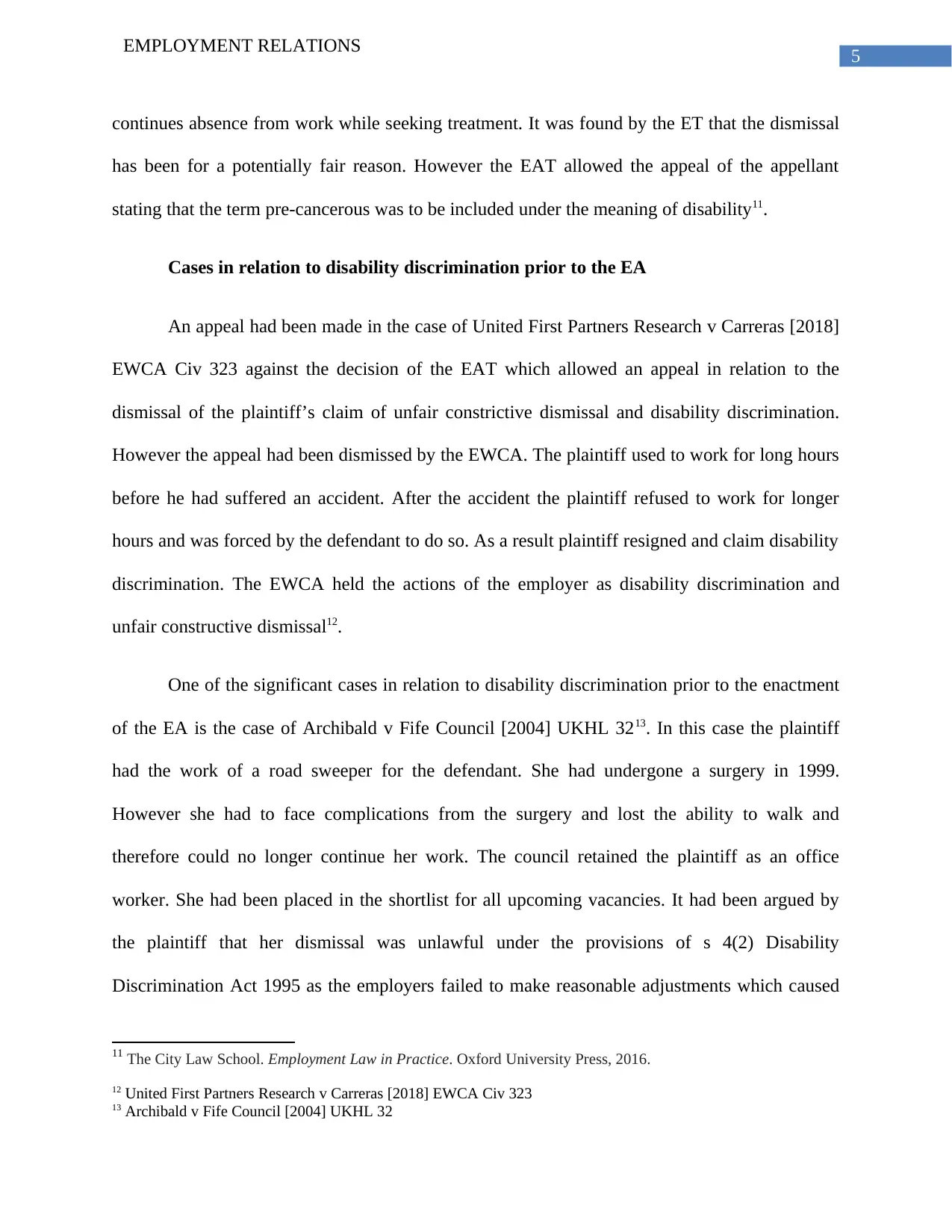
5
EMPLOYMENT RELATIONS
continues absence from work while seeking treatment. It was found by the ET that the dismissal
has been for a potentially fair reason. However the EAT allowed the appeal of the appellant
stating that the term pre-cancerous was to be included under the meaning of disability11.
Cases in relation to disability discrimination prior to the EA
An appeal had been made in the case of United First Partners Research v Carreras [2018]
EWCA Civ 323 against the decision of the EAT which allowed an appeal in relation to the
dismissal of the plaintiff’s claim of unfair constrictive dismissal and disability discrimination.
However the appeal had been dismissed by the EWCA. The plaintiff used to work for long hours
before he had suffered an accident. After the accident the plaintiff refused to work for longer
hours and was forced by the defendant to do so. As a result plaintiff resigned and claim disability
discrimination. The EWCA held the actions of the employer as disability discrimination and
unfair constructive dismissal12.
One of the significant cases in relation to disability discrimination prior to the enactment
of the EA is the case of Archibald v Fife Council [2004] UKHL 3213. In this case the plaintiff
had the work of a road sweeper for the defendant. She had undergone a surgery in 1999.
However she had to face complications from the surgery and lost the ability to walk and
therefore could no longer continue her work. The council retained the plaintiff as an office
worker. She had been placed in the shortlist for all upcoming vacancies. It had been argued by
the plaintiff that her dismissal was unlawful under the provisions of s 4(2) Disability
Discrimination Act 1995 as the employers failed to make reasonable adjustments which caused
11 The City Law School. Employment Law in Practice. Oxford University Press, 2016.
12 United First Partners Research v Carreras [2018] EWCA Civ 323
13 Archibald v Fife Council [2004] UKHL 32
EMPLOYMENT RELATIONS
continues absence from work while seeking treatment. It was found by the ET that the dismissal
has been for a potentially fair reason. However the EAT allowed the appeal of the appellant
stating that the term pre-cancerous was to be included under the meaning of disability11.
Cases in relation to disability discrimination prior to the EA
An appeal had been made in the case of United First Partners Research v Carreras [2018]
EWCA Civ 323 against the decision of the EAT which allowed an appeal in relation to the
dismissal of the plaintiff’s claim of unfair constrictive dismissal and disability discrimination.
However the appeal had been dismissed by the EWCA. The plaintiff used to work for long hours
before he had suffered an accident. After the accident the plaintiff refused to work for longer
hours and was forced by the defendant to do so. As a result plaintiff resigned and claim disability
discrimination. The EWCA held the actions of the employer as disability discrimination and
unfair constructive dismissal12.
One of the significant cases in relation to disability discrimination prior to the enactment
of the EA is the case of Archibald v Fife Council [2004] UKHL 3213. In this case the plaintiff
had the work of a road sweeper for the defendant. She had undergone a surgery in 1999.
However she had to face complications from the surgery and lost the ability to walk and
therefore could no longer continue her work. The council retained the plaintiff as an office
worker. She had been placed in the shortlist for all upcoming vacancies. It had been argued by
the plaintiff that her dismissal was unlawful under the provisions of s 4(2) Disability
Discrimination Act 1995 as the employers failed to make reasonable adjustments which caused
11 The City Law School. Employment Law in Practice. Oxford University Press, 2016.
12 United First Partners Research v Carreras [2018] EWCA Civ 323
13 Archibald v Fife Council [2004] UKHL 32
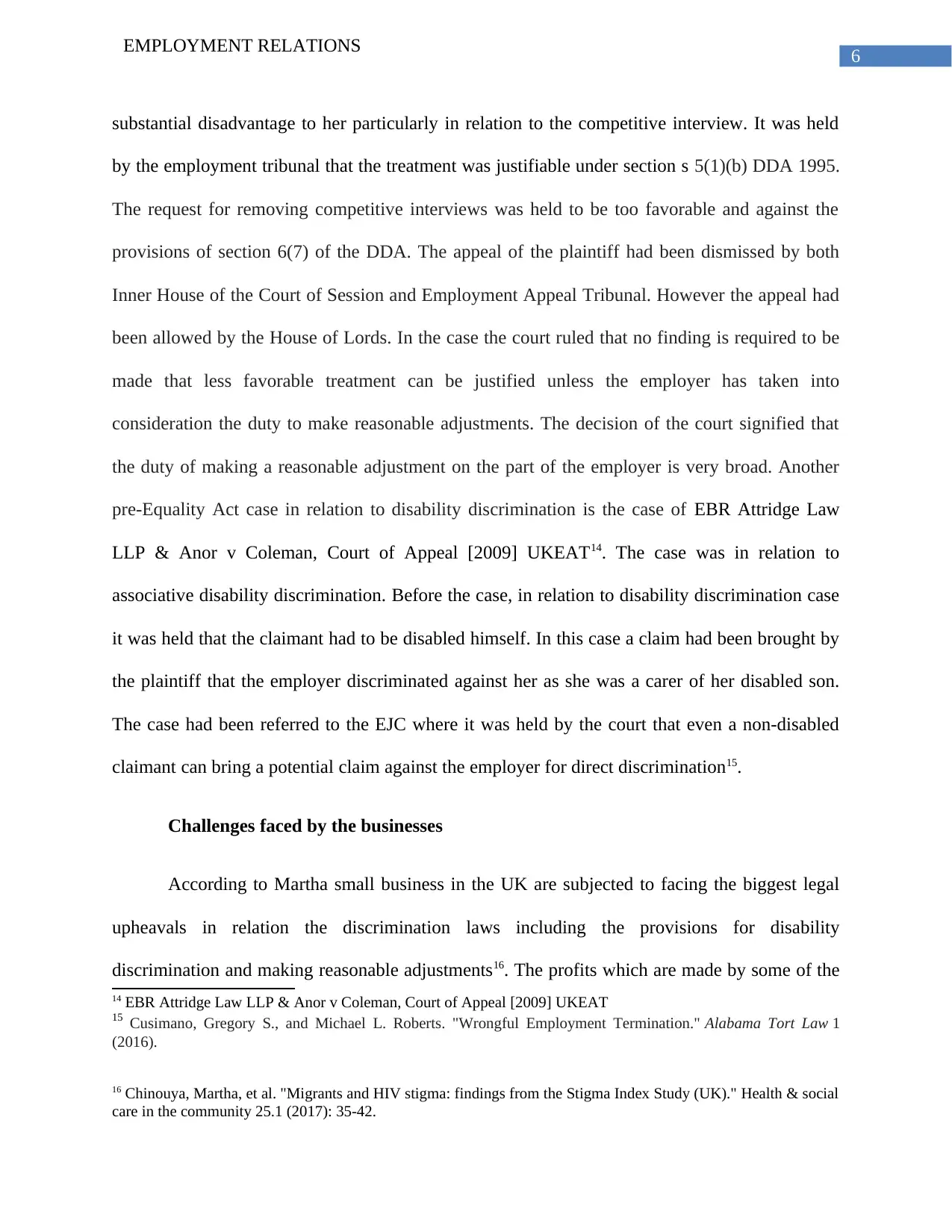
6
EMPLOYMENT RELATIONS
substantial disadvantage to her particularly in relation to the competitive interview. It was held
by the employment tribunal that the treatment was justifiable under section s 5(1)(b) DDA 1995.
The request for removing competitive interviews was held to be too favorable and against the
provisions of section 6(7) of the DDA. The appeal of the plaintiff had been dismissed by both
Inner House of the Court of Session and Employment Appeal Tribunal. However the appeal had
been allowed by the House of Lords. In the case the court ruled that no finding is required to be
made that less favorable treatment can be justified unless the employer has taken into
consideration the duty to make reasonable adjustments. The decision of the court signified that
the duty of making a reasonable adjustment on the part of the employer is very broad. Another
pre-Equality Act case in relation to disability discrimination is the case of EBR Attridge Law
LLP & Anor v Coleman, Court of Appeal [2009] UKEAT14. The case was in relation to
associative disability discrimination. Before the case, in relation to disability discrimination case
it was held that the claimant had to be disabled himself. In this case a claim had been brought by
the plaintiff that the employer discriminated against her as she was a carer of her disabled son.
The case had been referred to the EJC where it was held by the court that even a non-disabled
claimant can bring a potential claim against the employer for direct discrimination15.
Challenges faced by the businesses
According to Martha small business in the UK are subjected to facing the biggest legal
upheavals in relation the discrimination laws including the provisions for disability
discrimination and making reasonable adjustments16. The profits which are made by some of the
14 EBR Attridge Law LLP & Anor v Coleman, Court of Appeal [2009] UKEAT
15 Cusimano, Gregory S., and Michael L. Roberts. "Wrongful Employment Termination." Alabama Tort Law 1
(2016).
16 Chinouya, Martha, et al. "Migrants and HIV stigma: findings from the Stigma Index Study (UK)." Health & social
care in the community 25.1 (2017): 35-42.
EMPLOYMENT RELATIONS
substantial disadvantage to her particularly in relation to the competitive interview. It was held
by the employment tribunal that the treatment was justifiable under section s 5(1)(b) DDA 1995.
The request for removing competitive interviews was held to be too favorable and against the
provisions of section 6(7) of the DDA. The appeal of the plaintiff had been dismissed by both
Inner House of the Court of Session and Employment Appeal Tribunal. However the appeal had
been allowed by the House of Lords. In the case the court ruled that no finding is required to be
made that less favorable treatment can be justified unless the employer has taken into
consideration the duty to make reasonable adjustments. The decision of the court signified that
the duty of making a reasonable adjustment on the part of the employer is very broad. Another
pre-Equality Act case in relation to disability discrimination is the case of EBR Attridge Law
LLP & Anor v Coleman, Court of Appeal [2009] UKEAT14. The case was in relation to
associative disability discrimination. Before the case, in relation to disability discrimination case
it was held that the claimant had to be disabled himself. In this case a claim had been brought by
the plaintiff that the employer discriminated against her as she was a carer of her disabled son.
The case had been referred to the EJC where it was held by the court that even a non-disabled
claimant can bring a potential claim against the employer for direct discrimination15.
Challenges faced by the businesses
According to Martha small business in the UK are subjected to facing the biggest legal
upheavals in relation the discrimination laws including the provisions for disability
discrimination and making reasonable adjustments16. The profits which are made by some of the
14 EBR Attridge Law LLP & Anor v Coleman, Court of Appeal [2009] UKEAT
15 Cusimano, Gregory S., and Michael L. Roberts. "Wrongful Employment Termination." Alabama Tort Law 1
(2016).
16 Chinouya, Martha, et al. "Migrants and HIV stigma: findings from the Stigma Index Study (UK)." Health & social
care in the community 25.1 (2017): 35-42.
Paraphrase This Document
Need a fresh take? Get an instant paraphrase of this document with our AI Paraphraser
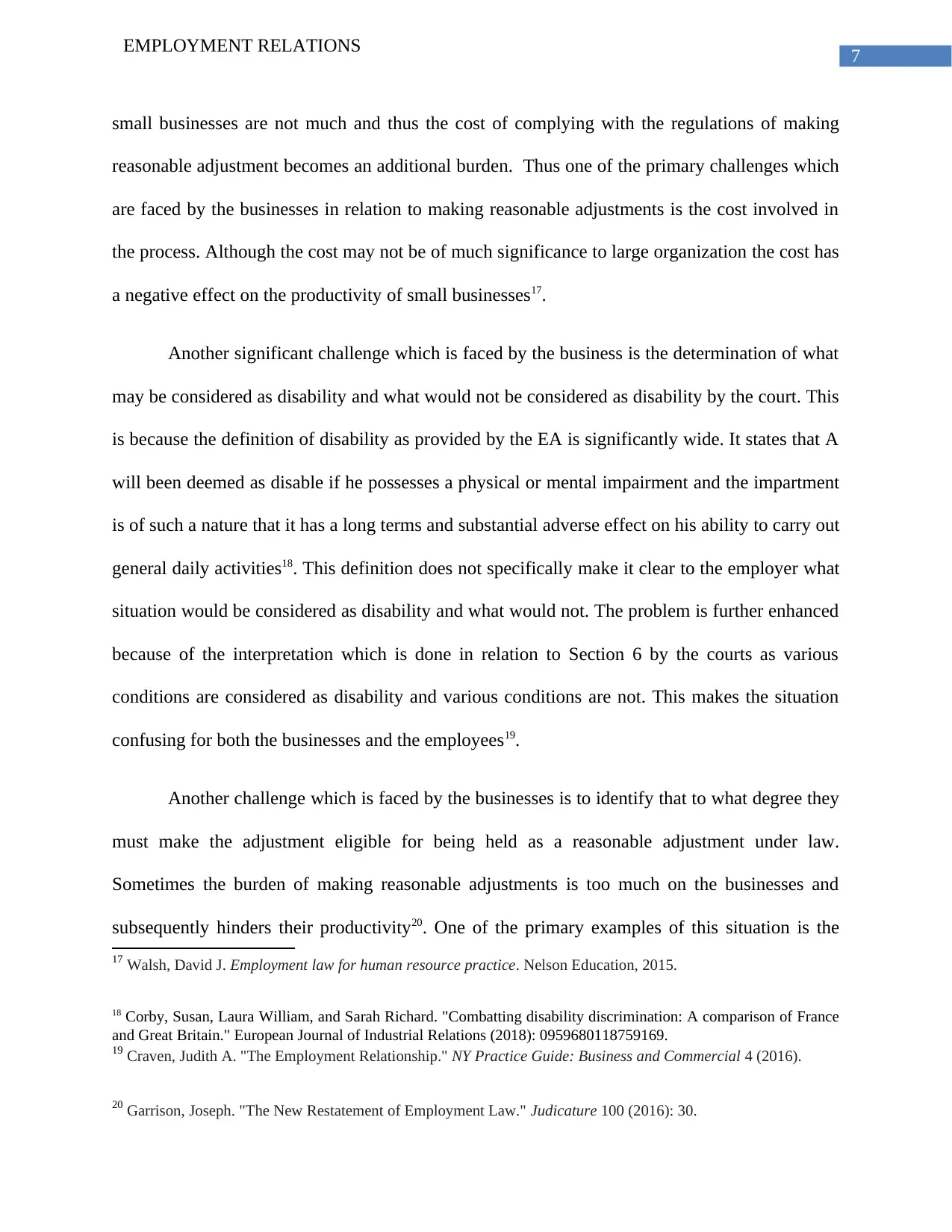
7
EMPLOYMENT RELATIONS
small businesses are not much and thus the cost of complying with the regulations of making
reasonable adjustment becomes an additional burden. Thus one of the primary challenges which
are faced by the businesses in relation to making reasonable adjustments is the cost involved in
the process. Although the cost may not be of much significance to large organization the cost has
a negative effect on the productivity of small businesses17.
Another significant challenge which is faced by the business is the determination of what
may be considered as disability and what would not be considered as disability by the court. This
is because the definition of disability as provided by the EA is significantly wide. It states that A
will been deemed as disable if he possesses a physical or mental impairment and the impartment
is of such a nature that it has a long terms and substantial adverse effect on his ability to carry out
general daily activities18. This definition does not specifically make it clear to the employer what
situation would be considered as disability and what would not. The problem is further enhanced
because of the interpretation which is done in relation to Section 6 by the courts as various
conditions are considered as disability and various conditions are not. This makes the situation
confusing for both the businesses and the employees19.
Another challenge which is faced by the businesses is to identify that to what degree they
must make the adjustment eligible for being held as a reasonable adjustment under law.
Sometimes the burden of making reasonable adjustments is too much on the businesses and
subsequently hinders their productivity20. One of the primary examples of this situation is the
17 Walsh, David J. Employment law for human resource practice. Nelson Education, 2015.
18 Corby, Susan, Laura William, and Sarah Richard. "Combatting disability discrimination: A comparison of France
and Great Britain." European Journal of Industrial Relations (2018): 0959680118759169.
19 Craven, Judith A. "The Employment Relationship." NY Practice Guide: Business and Commercial 4 (2016).
20 Garrison, Joseph. "The New Restatement of Employment Law." Judicature 100 (2016): 30.
EMPLOYMENT RELATIONS
small businesses are not much and thus the cost of complying with the regulations of making
reasonable adjustment becomes an additional burden. Thus one of the primary challenges which
are faced by the businesses in relation to making reasonable adjustments is the cost involved in
the process. Although the cost may not be of much significance to large organization the cost has
a negative effect on the productivity of small businesses17.
Another significant challenge which is faced by the business is the determination of what
may be considered as disability and what would not be considered as disability by the court. This
is because the definition of disability as provided by the EA is significantly wide. It states that A
will been deemed as disable if he possesses a physical or mental impairment and the impartment
is of such a nature that it has a long terms and substantial adverse effect on his ability to carry out
general daily activities18. This definition does not specifically make it clear to the employer what
situation would be considered as disability and what would not. The problem is further enhanced
because of the interpretation which is done in relation to Section 6 by the courts as various
conditions are considered as disability and various conditions are not. This makes the situation
confusing for both the businesses and the employees19.
Another challenge which is faced by the businesses is to identify that to what degree they
must make the adjustment eligible for being held as a reasonable adjustment under law.
Sometimes the burden of making reasonable adjustments is too much on the businesses and
subsequently hinders their productivity20. One of the primary examples of this situation is the
17 Walsh, David J. Employment law for human resource practice. Nelson Education, 2015.
18 Corby, Susan, Laura William, and Sarah Richard. "Combatting disability discrimination: A comparison of France
and Great Britain." European Journal of Industrial Relations (2018): 0959680118759169.
19 Craven, Judith A. "The Employment Relationship." NY Practice Guide: Business and Commercial 4 (2016).
20 Garrison, Joseph. "The New Restatement of Employment Law." Judicature 100 (2016): 30.

8
EMPLOYMENT RELATIONS
case of Archibald v Fife Council discussed above where arguably an additional burden had been
imposed on the employer due to the duty of making reasonable adjustments. The employees tend
to take advantage of the situation and make unreasonable adjustment request and if not complied
with they bring a discrimination claim against the employer21.
Conclusion and recommendations
Thus the problem with disability discrimination is not in relation to the inadequacy of
laws in UK. The law largely provides supports to disabled persons. The statistics depicted by
Smith are not a result of inadequacy of laws in the county. It is now the businesses who have
become a victim instead of those who are disabled.
In relation to the above discussed challenges there are some best practices
recommendations which may be followed by the business towards addressing compliance with
the present disability discrimination laws22.
The first and simplest measure which the businesses may have in place in order to
address the compliance of disability discrimination law is that of making proper and just
adjustments for those having disability like a reasonable person would have done in the same
situation. If the employer would be able to provide that they have taken all reasonable steps of
making the adjustment than they would not be held liable for disability discrimination23.
21 Guha, Martin. "Book Review." (2014): 347-349.
22 Rose, Emily. "David Cabrelli, Employment Law in Context." (2016): 105-106.
23 Degener, Theresia. "Intersections between disability, race and gender in discrimination law." European Union
non-discrimination law and intersectionality. Routledge, 2016. 39-56.
EMPLOYMENT RELATIONS
case of Archibald v Fife Council discussed above where arguably an additional burden had been
imposed on the employer due to the duty of making reasonable adjustments. The employees tend
to take advantage of the situation and make unreasonable adjustment request and if not complied
with they bring a discrimination claim against the employer21.
Conclusion and recommendations
Thus the problem with disability discrimination is not in relation to the inadequacy of
laws in UK. The law largely provides supports to disabled persons. The statistics depicted by
Smith are not a result of inadequacy of laws in the county. It is now the businesses who have
become a victim instead of those who are disabled.
In relation to the above discussed challenges there are some best practices
recommendations which may be followed by the business towards addressing compliance with
the present disability discrimination laws22.
The first and simplest measure which the businesses may have in place in order to
address the compliance of disability discrimination law is that of making proper and just
adjustments for those having disability like a reasonable person would have done in the same
situation. If the employer would be able to provide that they have taken all reasonable steps of
making the adjustment than they would not be held liable for disability discrimination23.
21 Guha, Martin. "Book Review." (2014): 347-349.
22 Rose, Emily. "David Cabrelli, Employment Law in Context." (2016): 105-106.
23 Degener, Theresia. "Intersections between disability, race and gender in discrimination law." European Union
non-discrimination law and intersectionality. Routledge, 2016. 39-56.
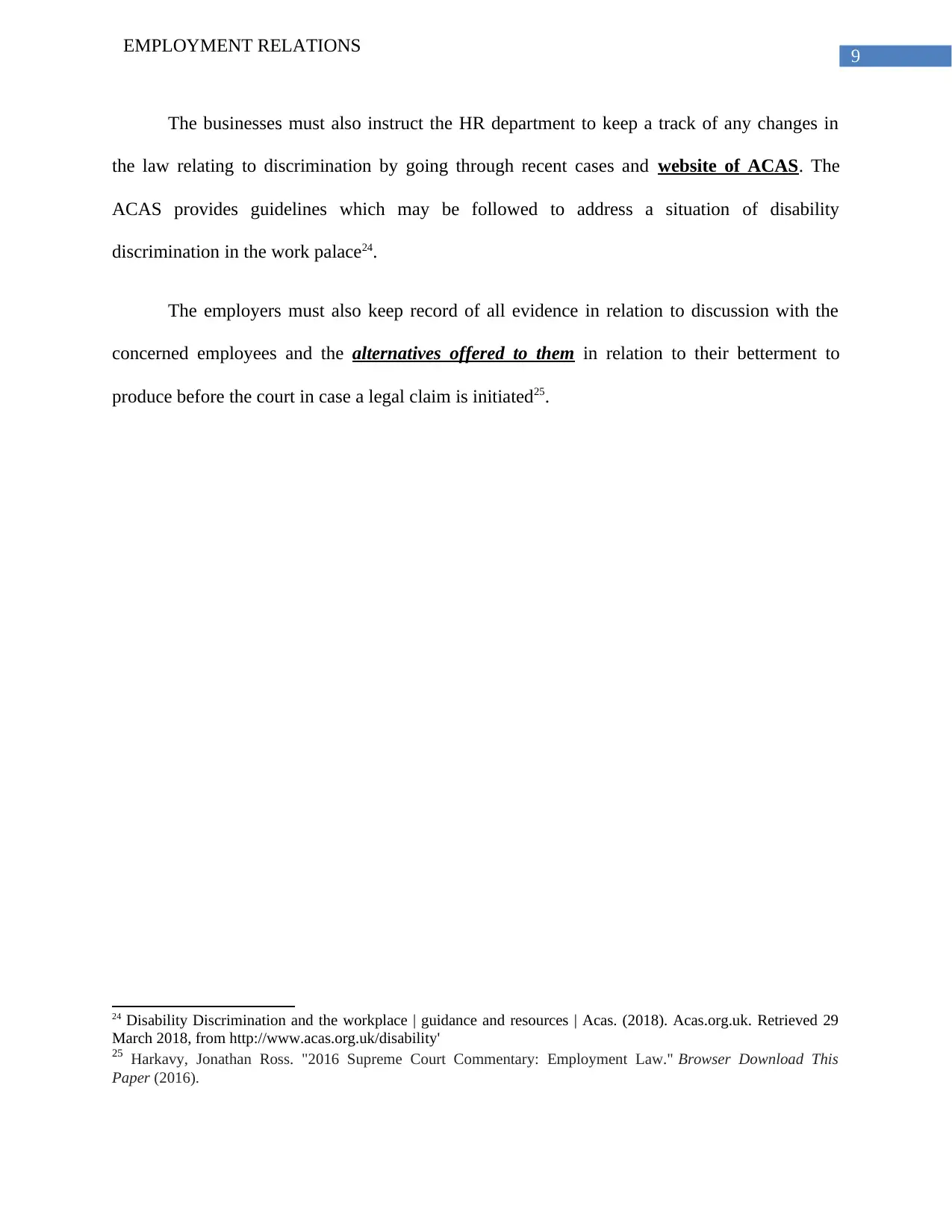
9
EMPLOYMENT RELATIONS
The businesses must also instruct the HR department to keep a track of any changes in
the law relating to discrimination by going through recent cases and website of ACAS. The
ACAS provides guidelines which may be followed to address a situation of disability
discrimination in the work palace24.
The employers must also keep record of all evidence in relation to discussion with the
concerned employees and the alternatives offered to them in relation to their betterment to
produce before the court in case a legal claim is initiated25.
24 Disability Discrimination and the workplace | guidance and resources | Acas. (2018). Acas.org.uk. Retrieved 29
March 2018, from http://www.acas.org.uk/disability'
25 Harkavy, Jonathan Ross. "2016 Supreme Court Commentary: Employment Law." Browser Download This
Paper (2016).
EMPLOYMENT RELATIONS
The businesses must also instruct the HR department to keep a track of any changes in
the law relating to discrimination by going through recent cases and website of ACAS. The
ACAS provides guidelines which may be followed to address a situation of disability
discrimination in the work palace24.
The employers must also keep record of all evidence in relation to discussion with the
concerned employees and the alternatives offered to them in relation to their betterment to
produce before the court in case a legal claim is initiated25.
24 Disability Discrimination and the workplace | guidance and resources | Acas. (2018). Acas.org.uk. Retrieved 29
March 2018, from http://www.acas.org.uk/disability'
25 Harkavy, Jonathan Ross. "2016 Supreme Court Commentary: Employment Law." Browser Download This
Paper (2016).
Secure Best Marks with AI Grader
Need help grading? Try our AI Grader for instant feedback on your assignments.
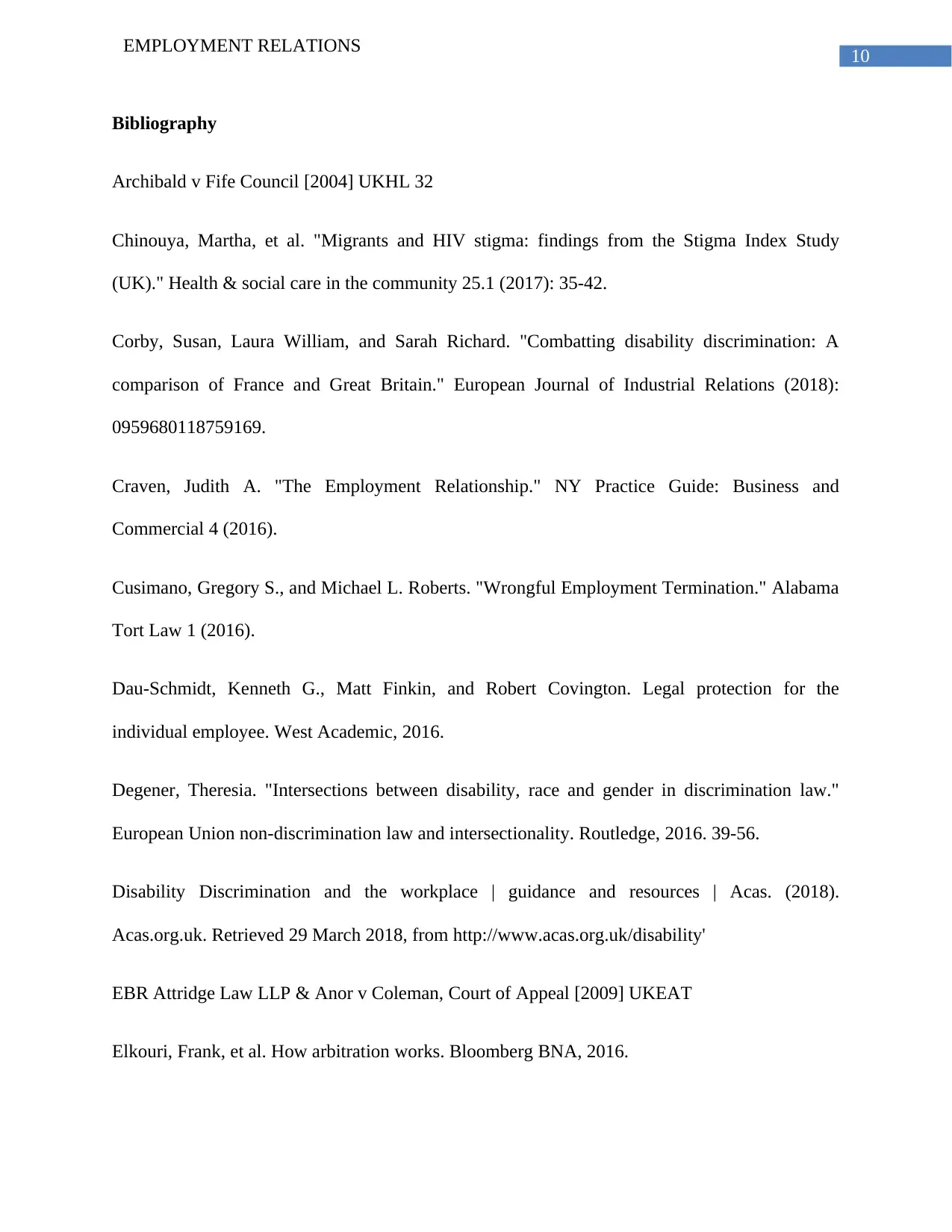
10
EMPLOYMENT RELATIONS
Bibliography
Archibald v Fife Council [2004] UKHL 32
Chinouya, Martha, et al. "Migrants and HIV stigma: findings from the Stigma Index Study
(UK)." Health & social care in the community 25.1 (2017): 35-42.
Corby, Susan, Laura William, and Sarah Richard. "Combatting disability discrimination: A
comparison of France and Great Britain." European Journal of Industrial Relations (2018):
0959680118759169.
Craven, Judith A. "The Employment Relationship." NY Practice Guide: Business and
Commercial 4 (2016).
Cusimano, Gregory S., and Michael L. Roberts. "Wrongful Employment Termination." Alabama
Tort Law 1 (2016).
Dau-Schmidt, Kenneth G., Matt Finkin, and Robert Covington. Legal protection for the
individual employee. West Academic, 2016.
Degener, Theresia. "Intersections between disability, race and gender in discrimination law."
European Union non-discrimination law and intersectionality. Routledge, 2016. 39-56.
Disability Discrimination and the workplace | guidance and resources | Acas. (2018).
Acas.org.uk. Retrieved 29 March 2018, from http://www.acas.org.uk/disability'
EBR Attridge Law LLP & Anor v Coleman, Court of Appeal [2009] UKEAT
Elkouri, Frank, et al. How arbitration works. Bloomberg BNA, 2016.
EMPLOYMENT RELATIONS
Bibliography
Archibald v Fife Council [2004] UKHL 32
Chinouya, Martha, et al. "Migrants and HIV stigma: findings from the Stigma Index Study
(UK)." Health & social care in the community 25.1 (2017): 35-42.
Corby, Susan, Laura William, and Sarah Richard. "Combatting disability discrimination: A
comparison of France and Great Britain." European Journal of Industrial Relations (2018):
0959680118759169.
Craven, Judith A. "The Employment Relationship." NY Practice Guide: Business and
Commercial 4 (2016).
Cusimano, Gregory S., and Michael L. Roberts. "Wrongful Employment Termination." Alabama
Tort Law 1 (2016).
Dau-Schmidt, Kenneth G., Matt Finkin, and Robert Covington. Legal protection for the
individual employee. West Academic, 2016.
Degener, Theresia. "Intersections between disability, race and gender in discrimination law."
European Union non-discrimination law and intersectionality. Routledge, 2016. 39-56.
Disability Discrimination and the workplace | guidance and resources | Acas. (2018).
Acas.org.uk. Retrieved 29 March 2018, from http://www.acas.org.uk/disability'
EBR Attridge Law LLP & Anor v Coleman, Court of Appeal [2009] UKEAT
Elkouri, Frank, et al. How arbitration works. Bloomberg BNA, 2016.
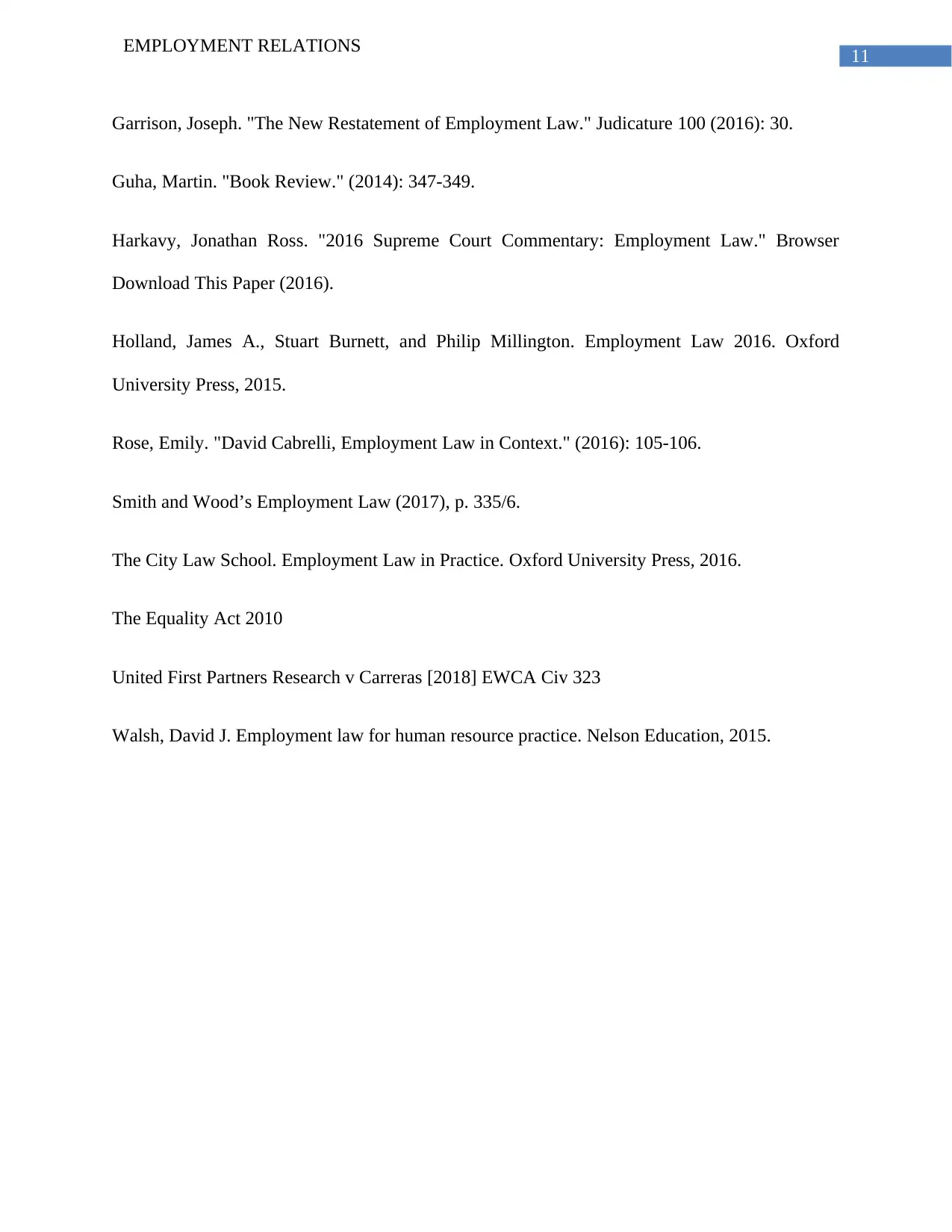
11
EMPLOYMENT RELATIONS
Garrison, Joseph. "The New Restatement of Employment Law." Judicature 100 (2016): 30.
Guha, Martin. "Book Review." (2014): 347-349.
Harkavy, Jonathan Ross. "2016 Supreme Court Commentary: Employment Law." Browser
Download This Paper (2016).
Holland, James A., Stuart Burnett, and Philip Millington. Employment Law 2016. Oxford
University Press, 2015.
Rose, Emily. "David Cabrelli, Employment Law in Context." (2016): 105-106.
Smith and Wood’s Employment Law (2017), p. 335/6.
The City Law School. Employment Law in Practice. Oxford University Press, 2016.
The Equality Act 2010
United First Partners Research v Carreras [2018] EWCA Civ 323
Walsh, David J. Employment law for human resource practice. Nelson Education, 2015.
EMPLOYMENT RELATIONS
Garrison, Joseph. "The New Restatement of Employment Law." Judicature 100 (2016): 30.
Guha, Martin. "Book Review." (2014): 347-349.
Harkavy, Jonathan Ross. "2016 Supreme Court Commentary: Employment Law." Browser
Download This Paper (2016).
Holland, James A., Stuart Burnett, and Philip Millington. Employment Law 2016. Oxford
University Press, 2015.
Rose, Emily. "David Cabrelli, Employment Law in Context." (2016): 105-106.
Smith and Wood’s Employment Law (2017), p. 335/6.
The City Law School. Employment Law in Practice. Oxford University Press, 2016.
The Equality Act 2010
United First Partners Research v Carreras [2018] EWCA Civ 323
Walsh, David J. Employment law for human resource practice. Nelson Education, 2015.
1 out of 12
Related Documents
Your All-in-One AI-Powered Toolkit for Academic Success.
+13062052269
info@desklib.com
Available 24*7 on WhatsApp / Email
![[object Object]](/_next/static/media/star-bottom.7253800d.svg)
Unlock your academic potential
© 2024 | Zucol Services PVT LTD | All rights reserved.





